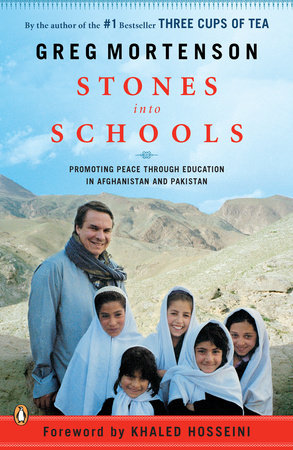Stones into Schools Reader’s Guide
By Greg Mortenson


INTRODUCTION
Picking up where Greg Mortenson’s inspiring first book, Three Cups of Tea, leaves off, Stones into Schools takes readers into the heart of Afghanistan during the last decade and explores Pakistan’s tragic 2005 earthquake, offering a vivid picture of the daily activities of the Central Asia Institute (CAI) and its ragtag team of unlikely heroes as they work and struggle with isolated communities to promote girls’ education and build schools in one the most challenging environments on earth.
Like Three Cups of Tea, Stones into Schools is fueled by a 1999 promise, this time to Abdul Rashid Khan, leader of the Kirgiz nomads, to bring a school to the high Pamir, one of Afghanistan’s most remote and desolate areas. Abandoned by the Afghan government and foreign NGOs the Kirgiz are impoverished and live without human services of any kind—no hospitals, roads, communication, electricity, or schools—but their desire to educate their children is unshakeable. Mortenson’s promise to build a school for them, or to help them build their own school, turns out to be painfully difficult to keep and took a decade to fulfill. But a promise, and the trust and faith it implies, are profoundly important to the Afghan people and indeed to Mortenson as well. The narrative arc and trajectory of Stones into Schools follows the superhuman efforts of Mortenson’s local CAI cohorts to fulfill this promise.
The CAI’s philosophy of “last-place-first”—to start their work not in cities where infrastructure and services already exist and then move outward into more remote villages, but to begin at the end of the road and move inwards toward urban areas—makes their efforts all the more daunting. It brings them into contact with those who need schools the most, communities where illiteracy is high, especially among girls, and where the flame of hope is perilously close to dying out.
Mortenson admits that he knows, at the outset, almost nothing about these communities—their subtle religious, cultural, and tribal affinities—which makes his method of asking questions and listening to the local people, especially the village elders and religious leaders, all the more important. Indeed, listening and letting the local people become their teachers proves to be one of the CAI’s keys to success.
While many nongovernmental organizations and government agencies assume they know how to “fix” the problems in distant countries like Afghanistan and take a top-down approach, Mortenson’s humbler method is not only more appealing, but also more effective. Afghan communities end up being not so much passive recipients as cocreators of their own schools, and for a proud, long-suffering, and above all resilient people, such self-agency makes all the difference. The CAI engages the local people to help plan and build the schools, and its track record speaks for itself: As of 2010, CAI has established 165 schools in Pakistan and Afghanistan, educating more than 68,000 students, 54,000 of whom are girls—in a region where Taliban resistance to girls’ education is so fierce that they have destroyed over 2,200 (mostly girls’) schools since 2007, poison and gas female students, and even throw battery acid in their faces.
If Mortenson’s approach—working with the local people, getting his hands dirty, learning the culture of Afghanistan—makes for better schools, it also makes for a better read. Stones into Schools bristles with the energy and commitment Mortenson and his cohorts at CAI bring to their work and lets readers in the West who will never set foot in Afghanistan or meet the extraordinary people who live there feel deeply connected to them. We feel not so much like were reading about Mortenson’s efforts in Afghanistan as participating in them.
Throughout the book we see the seemingly insurmountable logistical and cultural obstacles that it takes to initiate girls’ schools, the tremendous risks Mortenson and his colleagues choose to take, and the courage and commitment of the Afghan people as they fight to educate their children. We see, in short, a completely different Afghanistan than the one presented in the Western media. Indeed, in writing Stones into Schools, Greg Mortenson has done nearly as much to educate American readers as has been done to educate Afghan children.
Greg Mortenson is the director of the Central Asia Institute, founder of Pennies for Peace children’s program, and the author, with David Oliver Relin, of the New York Times bestseller Three Cups of Tea. A resident of Montana, he spends several months of the year in Pakistan and Afghanistan, when not home with his wife and two children.
Just for joining you’ll get personalized recommendations on your dashboard daily and features only for members.
Find Out More Join Now Sign In